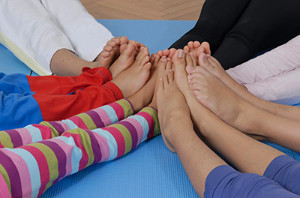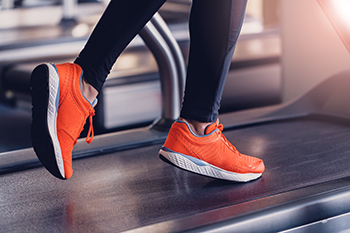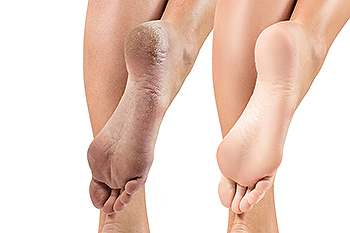NJ (908) 688-5577
NY (212) 737-2528

A baby’s foot contains more cartilage than bone, but will eventually have 26 bones in each foot when fully formed. Children's feet grow at a faster rate the younger they are. Within the first 3 years, a baby's foot coot could grow up to 9 sizes. Research has shown children have feet that are more durable than adult feet and can endure more stress. When it is time for the first pair of shoes to be purchased, it is beneficial that they effectively absorb shock and have strong soles. Many parents choose to have their children wear shoes that are made of leather and canvas materials, which are flexible and breathable fabrics. It is helpful to buy shoes that are the right size. If the shoe doesn’t fit correctly, unwanted foot conditions may develop that can include blisters and ingrown toenails. If you have questions about what type of shoes to buy for your child, it is suggested that you contact a podiatrist who can help you with the right footwear choices.
Making sure that your children maintain good foot health is very important as they grow. If you have any questions, contact Glenn Davison, DPM of Advanced Podiatry. Our doctor can provide the care you need to keep you pain-free and on your feet.
Keeping Children's Feet Healthy
Having healthy feet during childhood can help prevent medical problems later in life, namely in the back and legs. As children grow, their feet require different types of care. Here are some things to consider...
Although babies do not walk yet, it is still very important to take care of their feet.
Avoid putting tight shoes or socks on his or her feet.
Allow the baby to stretch and kick his or her feet to feel comfortable.
As a toddler, kids are now on the move and begin to develop differently. At this age, toddlers are getting a feel for walking, so don’t be alarmed if your toddler is unsteady or ‘walks funny’.
As your child gets older, it is important to teach them how to take care of their feet.
Show them proper hygiene to prevent infections such as fungus.
Be watchful for any pain or injury.
Have all injuries checked by a doctor as soon as possible.
Comfortable, protective shoes should always be worn, especially at play.
If you have any questions please feel free to contact our offices located in Union, NJ and New York . We offer the newest diagnostic and treatment technologies for all your foot and ankle needs.

Corns on the feet are a condition that is similar yet distinct from blisters. Essentially, corns are hardened layers of skin that can form in response to friction or pressure on the feet. Many patients often ask podiatrists to what extent pain can be felt from corns. The answer is complicated, because typically, many people do not feel pain in the beginning stages of developing a corn. However, if a corn becomes more severe as time passes, it may become uncomfortable. When the corn becomes irritated, it often increases the level of pain. In these situations, treatment can be sought to remedy the corn which may bring mild relief. If you are someone that is currently suffering from corns on the feet, it is suggested that you contact a podiatrist today for more information.
Foot Pain
Foot pain can be extremely painful and debilitating. If you have a foot pain, consult with Glenn Davison, DPM from Advanced Podiatry. Our doctor will assess your condition and provide you with quality foot and ankle treatment.
Causes
Foot pain is a very broad condition that could be caused by one or more ailments. The most common include:
Diagnosis
To figure out the cause of foot pain, podiatrists utilize several different methods. This can range from simple visual inspections and sensation tests to X-rays and MRI scans. Prior medical history, family medical history, and any recent physical traumatic events will all be taken into consideration for a proper diagnosis.
Treatment
Treatment depends upon the cause of the foot pain. Whether it is resting, staying off the foot, or having surgery; podiatrists have a number of treatment options available for foot pain.
If you have any questions, please feel free to contact our offices located in Union, NJ and New York . We offer the newest diagnostic and treatment technologies for all your foot care needs.

The feet can become strong when a consistent exercise regime is practiced. There are 26 bones, numerous tendons, and several ligaments that comprise each foot. Yoga has effective exercise and stretching techniques that target strengthening the feet. A heel sit is done by sitting on one foot at a time while kneeling on the other foot, and a stretch can be felt as the back foot is elongated. Calf raises can be equally as successful in keeping the feet strong. Many people enjoy having reflexology sessions, which are done by exerting pressure on various areas of the foot. This may be an effective method of strengthening the feet. Research has indicated that people who enjoy deadlifting may benefit by performing this type of strength training while barefoot. If you would like to learn more about what type of exercises can help the feet, it is suggested that you confer with a podiatrist who can provide you with the information you are seeking.
Exercising your feet regularly with the proper foot wear is a great way to prevent injuries and build strength. If you have any concerns about your feet, contact Glenn Davison, DPM from Advanced Podiatry. Our doctor can provide the care you need to keep you pain-free and on your feet.
Exercise for Your Feet
Exercise for your feet can help you gain strength, mobility and flexibility in your feet. They say that strengthening your feet can be just as rewarding as strengthening another part of the body. Your feet are very important, and we often forget about them in our daily tasks. But it is because of our feet that are we able to get going and do what we need to. For those of us fortunate enough to not have any foot problems, it is an important gesture to take care of them to ensure good health in the long run.
Some foot health exercises can include ankle pumps, tip-toeing, toe rises, lifting off the floor doing reps and sets, and flexing the toes. It is best to speak with Our doctor to determine an appropriate regimen for your needs. Everyone’s needs and bodies are different, and the activities required to maintain strength in the feet vary from individual to individual.
Once you get into a routine of doing regular exercise, you may notice a difference in your feet and how strong they may become.
If you have any questions please feel free to contact our offices located in Union, NJ and New York . We offer the newest diagnostic and treatment technologies for all your foot and ankle needs.

Having a vitamin deficiency may be a cause for cracked heels to develop. It can be an unsightly and uncomfortable foot condition. Mildly cracked heels affect the top layer of the skin, and it is generally a painless ailment. Fissures are defined as severely cracked heels that may bleed and become infected. Studies show that a lack of vitamin E may affect the collagen in the skin. This is linked to the drying effect that aging has on the skin and may increase the risk of developing cracked heels. It can be beneficial to add foods, such as sunflower seeds, salmon, and avocado to your diet, which are laden with vitamin E. Patients who do not get adequate amounts of vitamin B-3 in their diet may notice their skin becomes dry and scaly, which may be followed by getting cracked heels. If you have questions about how cracked heels are connected to vitamin deficiencies, it is suggested that you speak with a podiatrist.
Cracked heels are unsightly and can cause further damage to your shoes and feet. If you have any concerns, contact Glenn Davison, DPM from Advanced Podiatry. Our doctor can provide the care you need to keep you pain-free and on your feet.
Cracked Heels
Cracked heels appear unappealing and can make it harder for you walk around in sandals. Aside from looking unpleasant, cracked heels can also tear stockings, socks, and wear out your shoes. There are several methods to help restore a cracked heel and prevent further damage.
How Do You Get Them?
Dry skin is the number one culprit in creating cracked heels. Many athletes, walkers, joggers, and even swimmers suffer from cracked heels. Age and skin oil production play a role to getting cracked heels as well.
Promote Healing
Over the counter medicines can help, especially for those that need instant relief or who suffer from chronic dry feet.
Wear Socks – Wearing socks with medicated creams helps lock in moisture.
Moisturizers – Applying both day and night will help alleviate dryness which causes cracking.
Pumice Stones – These exfoliate and remove dead skin, which allows for smoother moisturizer application and better absorption into the skin.
Change in Diet
Eating healthy with a well-balanced diet will give the skin a fresh and radiant look. Your body responds to the kinds of food you ingest. Omega-3 fatty acids and zinc supplements can also revitalize skin tissue.
Most importantly, seek professional help if unsure how to proceed in treating cracked heels. A podiatrist will help you with any questions or information needed.
If you have any questions, please feel free to contact our offices located in Union, NJ and New York . We offer the newest diagnostic and treatment technologies for all your foot care needs.

Running can be an exhilarating way for individuals to exercise. However, it can also put significant strain on the feet. If the feet are not properly cared for and stretched, running may put the feet at increased risk of injury. Runners might stand to benefit from performing certain specific foot stretches. For instance, if you are a runner, you might consider performing lacrosse ball plantar surface rolling. This may be done from a seated position where you place a ball underneath the foot and gently roll the ball forward and backward across your plantar fascia. This can be performed for one minute on each foot. By performing this stretch, a runner can effectively stretch their plantar fascia and prepare it for more running. If you are a runner and are looking to prevent injury, it is recommended that you schedule an appointment with a podiatrist.
Stretching the feet is a great way to prevent injuries. If you have any concerns with your feet consult with Glenn Davison, DPM from Advanced Podiatry. Our doctor will assess your condition and provide you with quality foot and ankle treatment.
Stretching the Feet
Being the backbone of the body, the feet carry your entire weight and can easily become overexerted, causing cramps and pain. As with any body part, stretching your feet can serve many benefits. From increasing flexibility to even providing some pain relief, be sure to give your feet a stretch from time to time. This is especially important for athletes or anyone performing aerobic exercises, but anyone experiencing foot pain or is on their feet constantly should also engage in this practice.
Great ways to stretch your feet:
Individuals who tend to their feet by regular stretching every day should be able to minimize foot pain and prevent new problems from arising.
If you have any questions, please feel free to contact our offices located in Union, NJ and New York . We offer the newest diagnostic and treatment technologies for all your foot care needs.